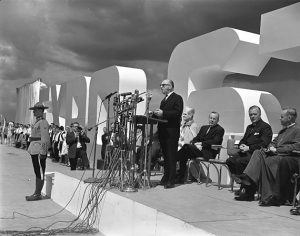
What’s new?
In an email exchange from May 2016, obtained by using provincial access to information laws, ecosystem biologists Kyle Rezansoff and Kerry Harvey have expressed their professional concern that a potential coal mine in B.C. will threaten a nearby caribou herd.
Why it’s important?
The proposed Sukunka coal mine would be expected to last for 20 years and to be dug near the Peace River Valley in the north-eastern corner of the province by multinational mining company Glencore. Because the coal mining project falls into the habitat of the endangered Quintette herd, it would place it in even greater peril.

The Government of British Columbia says that the Quintette’s endangered status is a “result of habitat loss, fragmentation and alteration, and an increased predation associated with various forms of industrial activity”. Information on Central Mountain Caribou
The biologists expressed concern that the Sukunka project will threaten the caribou if it is to be built within less than three kilometres of the caribou habitat on the high elevation winter range. Glencore proposed it be built within 500 metres. The distance between the caribou’s habitat and human activity is what the biologists called a “buffer zone”.
On May 5th 2016, Rezansoff wrote to Harvey about Eco-Logic’s 500- metres buffer zone. “I don’t know how well we can rely on that distance being suitable”, he said. “We have science stating that the caribou are negatively affected up to four kilometres away from industrial activity”, before adding, “a conservative three-kilometre buffer zone from the Sukunka project seems to be reasonable”.
On the same day, Harvey wrote: “I’ve just been sitting here reflecting on about the Sukunka caribou call we participated and have some concerns looking forward to tomorrow’s conversation”.
Harvey then added that it seems obvious a precautionary approach be taken when dealing with the Quintette, given their endangered nature and that the three-kilometre buffer zone should be suggested during the conversation with their superiors.
What the government says?
It is unknown whether the experts’ advice was followed or not. The Ministry of Forests, Lands and Natural Resources Operations did not reply to multiple attempts to contact them about the buffer zone’s width.
The government of British Columbia does not say when the Sukunka project’s review will be finished.
The emails were released in October 2016 and the project is still under review. State of the Sukunka project under the Environmental Assessment Office of British Columbia.
What other people say?
According to Chris Johnson, an Ecosystem Science and Management Program Professor of the University of Northern British Columbia, coal mines can leave a huge footprint on the caribou and can result in the loss of a large area of caribou habitat. Johnson spent 11 years collecting data about caribou range in BC.
He said that “the consensus among most people is that the high elevation range shouldn’t be disturbed.” These open mines often are dug on top of mountains says the professor, and this landscape is preferred by the caribou.
Johnson says that open mines like Glencore plans to dig are often dug on top of mountains and they do two things: drive caribou away to lower regions where wolves live and also open up trails for wolves to travel up to high elevation range that caribou may still inhabit. Wolves are the caribou’s main predator.
What’s next?
Johnson says it seems counter-intuitive that the B.C. Government would announce a $27M investment into caribou protection last month and potentially approve a multinational’s project that would place one of the biggest herds of the region in peril.
“500 metres is not very far- four kilometres is a lot farther, but it’s not very far either”, says Johnson.

Glencore’s response to inquiries about buffer zones was: “Part of our [environmental assessment] discussion is aimed at getting consensus on the appropriate distances between any future mining activity and this habitat”.



